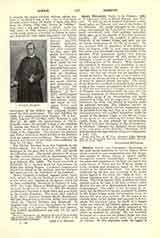

Alexis Falconieri, Saint, b. in Florence, 1200; d. February 17, 1310, at Mount Senario, near Florence. He was the son of Bernard Falconieri, a merchant prince of Florence, and one of the leaders of the Republic. His family belonged to the Guelph party, and opposed the Imperialists whenever they could consistently with their political principles. Alexis grew up in the practice of the most profound humility. He joined the Laudesi, a pious confraternity of the Blessed Virgin, and there met the six future companions of his life of sanctity. He was favored with an apparition of the Mother of God, August 15, 1233, as were these companions. The seven soon afterwards founded the Order of the Servites. With consistent loyalty and heroism Alexis at once abandoned all, and retired to La Camarzia, a house on the outskirts of the town, and the following year to Mt. Senario. With characteristic humility, he traversed, as a mendicant, in quest of alms for his brethren, the streets of the city through which he had lately moved as a prominent citizen. So deep and sincere was his humility that, though he lived to the great age of one hundred and ten years, he always refused to enter the priesthood, of which he deemed himself unworthy. The duties of our Saint were confined principally to the material needs of the various communities in which he lived. In 1252 the new church at Cafaggio, on the outskirts of Florence, was completed under his care, with the financial assistance of Chiarissimo Falconieri. The miraculous image of the Annunciation, still highly venerated in Italy, had its origin here. St. Juliana Falconieri, his niece, was trained in sanctity under his personal direction. The influence exerted on his countrymen by Alexis and his companions may be gathered from the fact that in a few years ten thousand persons had enrolled themselves under the banner of the Blessed Virgin in the Servite Order. At his death he was visited by the Infant Jesus in visible form, as was attested by eyewitnesses. His body rests near the church of the Annunciation, in Florence. Clement XI declared Alexis worthy of the veneration of the faithful, December 1, 1717, and accorded the same honor to his six companions, July 3, 1725.
AUGUSTINE MCGINNIS

